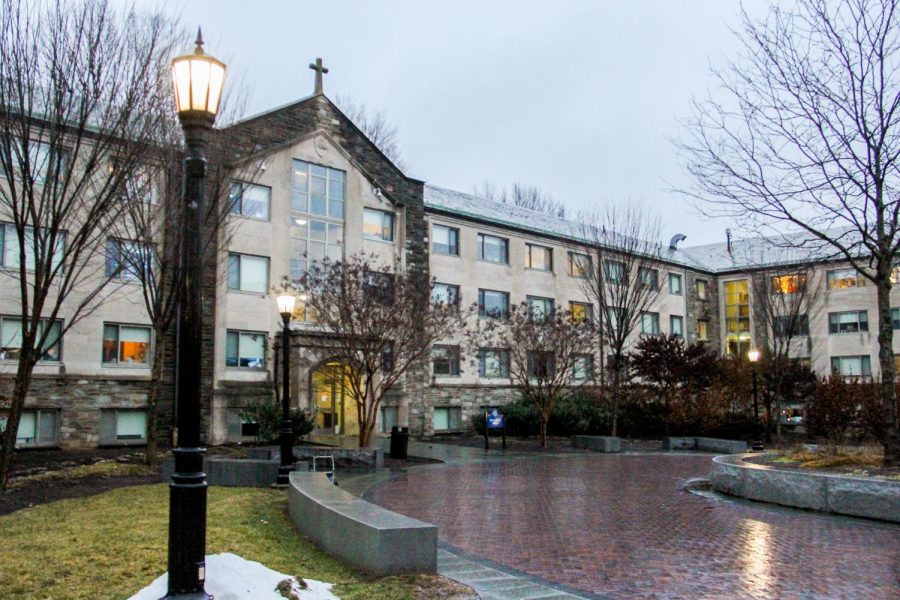Too Hot to Handle: Switch HVAC Systems to Cooling
Courtesy of Peter Licopantis/Villanovan Photography
Despite technical complications to consider, temperatures are too warm for dorm HVAC systems to stay on heating mode.
April 6, 2022
Spring at Villanova is finally here with the trees blossoming, the sun shining and, obviously, the temperatures rising. With this change in climate, the heating units in all dorm buildings should be switched to air conditioning, but Villanova Residence Life, unfortunately, thinks differently.
On March 18, Residence Life sent out an email to all students expressing that the heating would not be switched to air conditioning any earlier than April 15. The explanation was that temperatures can fluctuate from the 70s all the way down into the 20s, and it is not an easy task to switch the heating from AC.
The email also described how different buildings on campus have different HVAC systems. Buildings like Caughlin, McGuire, Katharine and St. Monica have HVAC systems similar to those in hotels where one can switch from heat to air conditioning whenever needed. The email’s explanations did not include why all systems on campus cannot operate this way.
Buildings such as Delurey, Moriarty, O’Dwyer, Simpson and St. Rita’s operate by window units. Notably, though, the window units are locked until a certain point so freezing temperatures don’t ruin the units. However, the warmer April temperatures beg the question: where are these freezing temperatures that would ruin the systems?
Finally, and perhaps the most confusing, are the systems in Alumni, Austin, Corr, Fedigan, Good Counsel, Sheehan, Stanford and Sullivan Halls. These buildings, along with all dorms on West Campus and in the Commons, are controlled by a central heating and cooling station, meaning the heat cannot be changed to air until the main station is switched.
Importantly, considering that the Commons apartments opened less than three years ago, why weren’t they given the option of a self-controlling HVAC system like the south campus dorms? It seems more convenient to have each person decide when their heat and air should change as the people who are living in the room.
Overall, the March 18 email brought annoyance because the given date, April 15, means students can only enjoy the comfort of air conditioning for two weeks before the end of the school year.
Additionally, since the email the weather has not dropped below the 30s at night, let alone in the day. Even if it did, students have blankets and winter clothes to layer in in case the temperature dips. Not turning the heating off seems to be more of a hassle than a gift.
Students shared how they felt about the AC not being switched for a while. Freshman Sydney Barhite lives in Alumni Hall and described how she felt about the air conditioning not being on for at least another month.
“I’m not thrilled about it,” Barhite said. “It is too hot, especially at night. It is hard for me to fall asleep and stay asleep.”
Although the late switch to cooling poses a problem for many, others are adapting to the HVAC system and aren’t concerned when it switches to AC. Senior Ryan Haack, who lives in The Commons, discussed the HVAC systems and temperatures in his room.
“I don’t know much about HVAC and how all that works, but my understanding of it, while I was an RA, is that somehow all systems in the building are connected,” Haack said. “I’m sure it’s difficult to pick the right date to switch over. I’m personally not one to care too much about the thermostat anyway. Opening or closing the window has regulated the temperatures just fine throughout the year.”
David Roth, the Assistant Director of Maintenance Residence Life, provided insight into the seemingly absurd procedure.
“We use the April 15 date as a guide,” Roth said. “It is not written in stone when we will turn on the air conditioning in the Spring or the heat in the Fall.”
Roth also explained the process of changing from heat to air conditioning, and it does seem to be an intricate process.
“The changeover involves an intricate process of closing and opening valves between the two systems and allowing an eight-hour cooldown or heat up time to avoid thermal shocking the system to completely switch over,” Roth said.
“Because of the nature of this process, we collect all the data and make the switch when it makes the most sense based on that data. Our goal is to obviously make the decision that will be least impactful to our customers on campus both in the dorms and the academic buildings, but sometimes Mother Nature throws us a curveball, and we get caught being uncomfortable for a short period of time.”
Roth also explained the reasoning behind the HVAC systems in the Commons.
“While the self-controlling systems like the ones at the four low rise dorms on South Campus seem to make the most sense from a user standpoint, they are not the most efficient,” Roth said.
“When looking at new construction like the Commons were, the most efficient, cost-effective and environmentally friendly design was the central plant with individual fan coils.”
All in all, despite the technical considerations, waiting to turn the heating off is too uncomfortable of an annoyance to wait any longer. Windows are a great alternative, but they can only do so much on humid and consistently warm days.
Although Residence Life uses April 15 as a guideline, it seems the air conditioning will not be coming on soon. The heat needs to be turned off to make it truly feel like spring.










